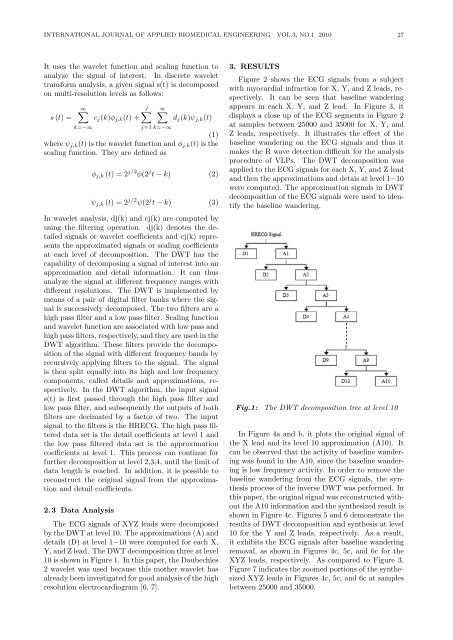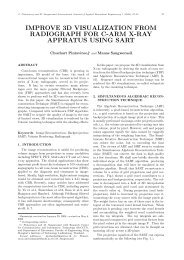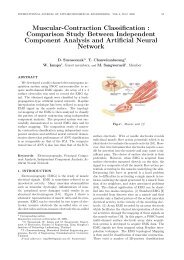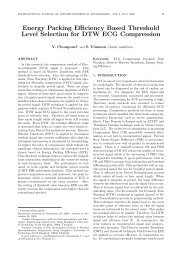Discrete Wavelet Transform-based Baseline Wandering ... - ijabme.org
Discrete Wavelet Transform-based Baseline Wandering ... - ijabme.org
Discrete Wavelet Transform-based Baseline Wandering ... - ijabme.org
Create successful ePaper yourself
Turn your PDF publications into a flip-book with our unique Google optimized e-Paper software.
INTERNATIONAL JOURNAL OF APPLIED BIOMEDICAL ENGINEERING VOL.3, NO.1 2010 27<br />
It uses the wavelet function and scaling function to<br />
analyze the signal of interest. In discrete wavelet<br />
transform analysis, a given signal s(t) is decomposed<br />
on multi-resolution levels as follows:<br />
s (t) =<br />
∞∑<br />
k=−∞<br />
c j (k)φ j,k (t) +<br />
J∑<br />
∞∑<br />
j=1 k=−∞<br />
d j (k)ψ j,k (t)<br />
(1)<br />
where ψ j,k (t) is the wavelet function and φ j,k (t) is the<br />
scaling function. They are defined as<br />
φ j,k (t) = 2 j/2 φ(2 j t − k) (2)<br />
ψ j,k (t) = 2 j/2 ψ(2 j t − k) (3)<br />
In wavelet analysis, dj(k) and cj(k) are computed by<br />
using the filtering operation. dj(k) denotes the detailed<br />
signals or wavelet coefficients and cj(k) represents<br />
the approximated signals or scaling coefficients<br />
at each level of decomposition. The DWT has the<br />
capability of decomposing a signal of interest into an<br />
approximation and detail information. It can thus<br />
analyze the signal at different frequency ranges with<br />
different resolutions. The DWT is implemented by<br />
means of a pair of digital filter banks where the signal<br />
is successively decomposed. The two filters are a<br />
high pass filter and a low pass filter. Scaling function<br />
and wavelet function are associated with low pass and<br />
high pass filters, respectively, and they are used in the<br />
DWT algorithm. These filters provide the decomposition<br />
of the signal with different frequency bands by<br />
recursively applying filters to the signal. The signal<br />
is then split equally into its high and low frequency<br />
components, called details and approximations, respectively.<br />
In the DWT algorithm, the input signal<br />
s(t) is first passed through the high pass filter and<br />
low pass filter, and subsequently the outputs of both<br />
filters are decimated by a factor of two. The input<br />
signal to the filters is the HRECG. The high pass filtered<br />
data set is the detail coefficients at level 1 and<br />
the low pass filtered data set is the approximation<br />
coefficients at level 1. This process can continue for<br />
further decomposition at level 2,3,4, until the limit of<br />
data length is reached. In addition, it is possible to<br />
reconstruct the original signal from the approximation<br />
and detail coefficients.<br />
2.3 Data Analysis<br />
The ECG signals of XYZ leads were decomposed<br />
by the DWT at level 10. The approximations (A) and<br />
details (D) at level 1−10 were computed for each X,<br />
Y, and Z lead. The DWT decomposition three at level<br />
10 is shown in Figure 1. In this paper, the Daubechies<br />
2 wavelet was used because this mother wavelet has<br />
already been investigated for good analysis of the high<br />
resolution electrocardiogram [6, 7].<br />
3. RESULTS<br />
Figure 2 shows the ECG signals from a subject<br />
with myocardial infraction for X, Y, and Z leads, respectively.<br />
It can be seen that baseline wandering<br />
appears in each X, Y, and Z lead. In Figure 3, it<br />
displays a close up of the ECG segments in Figure 2<br />
at samples between 25000 and 35000 for X, Y, and<br />
Z leads, respectively. It illustrates the effect of the<br />
baseline wandering on the ECG signals and thus it<br />
makes the R wave detection difficult for the analysis<br />
procedure of VLPs. The DWT decomposition was<br />
applied to the ECG signals for each X, Y, and Z lead<br />
and then the approximations and detais at level 1−10<br />
were computed. The approximation signals in DWT<br />
decomposition of the ECG signals were used to identify<br />
the baseline wandering.<br />
Fig.1: The DWT decomposition tree at level 10<br />
In Figure 4a and b, it plots the original signal of<br />
the X lead and its level 10 approximation (A10). It<br />
can be observed that the activity of baseline wandering<br />
was found in the A10, since the baseline wandering<br />
is low frequency activity. In order to remove the<br />
baseline wandering from the ECG signals, the synthesis<br />
process of the inverse DWT was performed. In<br />
this paper, the original signal was reconstructed without<br />
the A10 information and the synthesized result is<br />
shown in Figure 4c. Figures 5 and 6 demonstrate the<br />
results of DWT decomposition and synthesis at level<br />
10 for the Y and Z leads, respectively. As a result,<br />
it exhibits the ECG signals after baseline wandering<br />
removal, as shown in Figures 4c, 5c, and 6c for the<br />
XYZ leads, respectively. As compared to Figure 3,<br />
Figure 7 indicates the zoomed portions of the synthesized<br />
XYZ leads in Figures 4c, 5c, and 6c at samples<br />
between 25000 and 35000.











